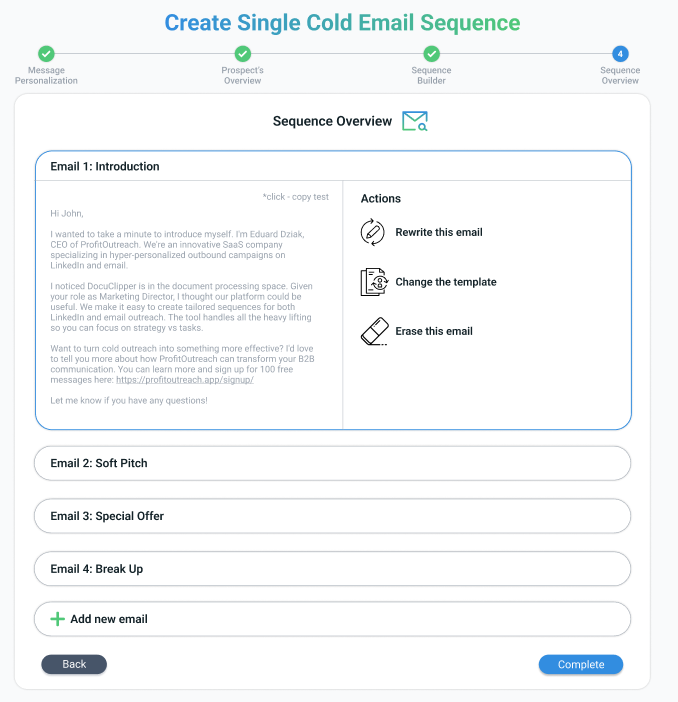Crafting the best cold email subject lines is vital for sales and marketing outreach success, especially with inboxes filled to the top and attention span shorter than goldfish, you have a split second to get recipients to open your cold email message.
This article will show you nine proven best practices for writing the best cold email subject lines, complete with power words and real-life examples that have delivered responses.
By implementing these research-backed and tested guidelines for subject line creation and optimization, you can transform cold email outreach and open the door for more sales opportunities.
Why are Subject Lines Important?
Your cold email must stand out from the crowd if you want it to be opened, read, and acted upon. This is no easy feat considering the deluge of emails professionals face daily.
As DMR reports show, the average office worker receives 121 emails per day. With inboxes at overflowing capacity, subject lines have outsized importance in cutting through the noise.
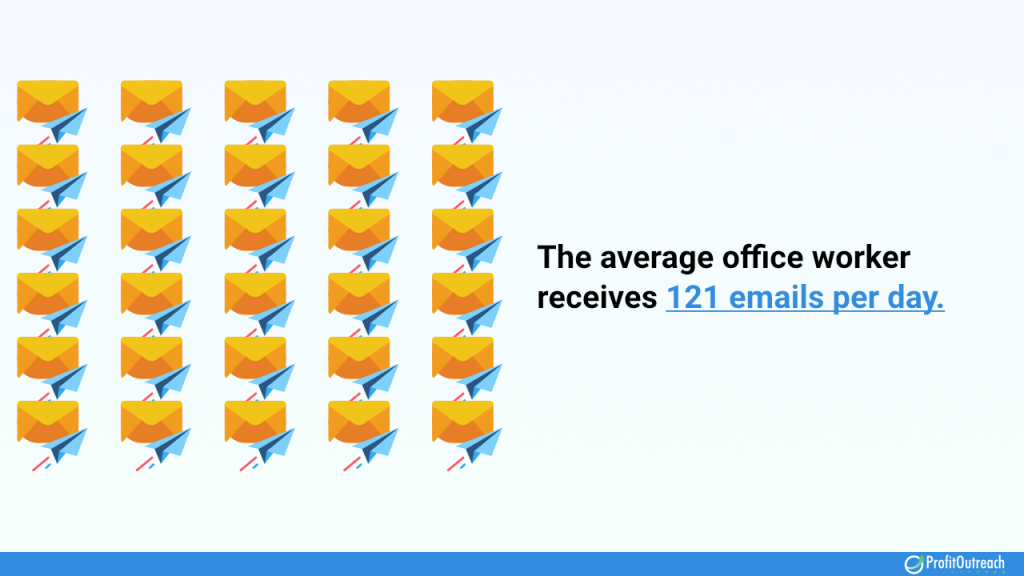
Recent cold email trends show that personalization and relevance are becoming increasingly crucial as inbox competition intensifies.
In fact, 33% of email recipients decide whether to open a message based solely on the subject line. This headline preview gives them a snapshot sense of your email’s contents and value proposition giving you the only chance to get prospects to know your brand.
Especially with attention spans shrinking, your subject line has mere seconds to compel opening.
So, it’s clear that poorly crafted or generic subject lines can severely limit email effectiveness.
On the other hand, compelling, benefit-driven headlines that speak directly to the recipient have been shown to drive dramatically higher open and response rates.
A/B testing of cold email subject lines and content can result in up to 28% higher ROI as you identify what resonates most with your audience. (Cold email statistics)
The bottom line is that hyper-focused effort on writing and optimizing your cold email subject lines pays dividends. When done right, it gets your foot in the door so prospects read, respond, and convert.
Best Practices to Craft Best Cold Email Subject Lines
Crafting irresistible cold email subject lines is an art and a science as well as an experience.
Every industry is different, because of how your prospects think and work. Therefore it’s essential to test as many subject line variants as possible to see which one works the best in your industry.
By following our guidelines grounded in research around email marketing, psychology, and reader behavior, plus some of the good old cold email tips you can drastically improve open, click, and response rates.
In this section, we will reveal nine proven best practices for writing subject lines that compel action and deliver results.
Practice #1: Personalization, Personalization, Personalization
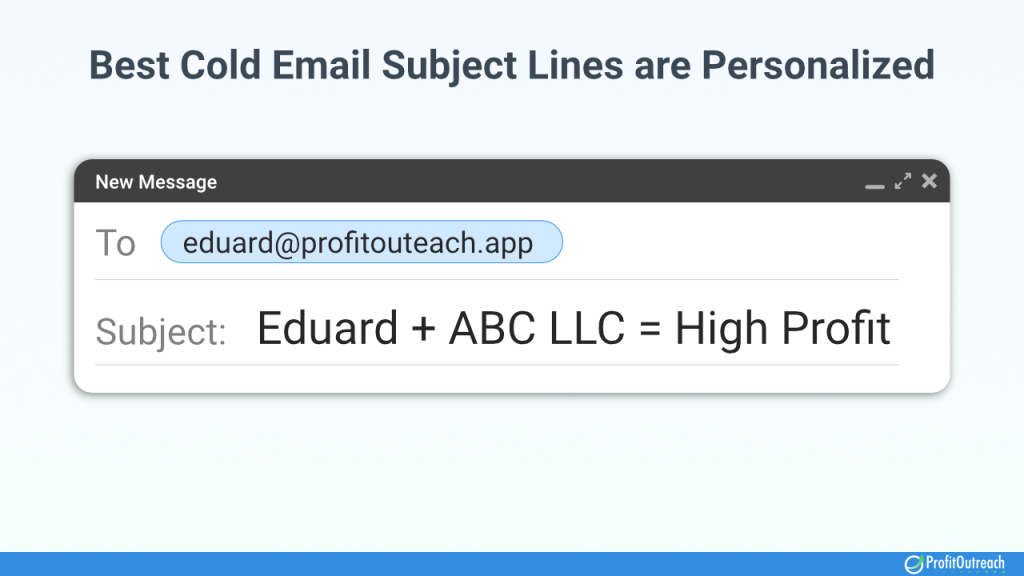
Personalizing your cold email subject lines pays big dividends. In fact, research by Backlinko indicates that personalized subject lines boost response rates by 30.5% compared to generic headlines.
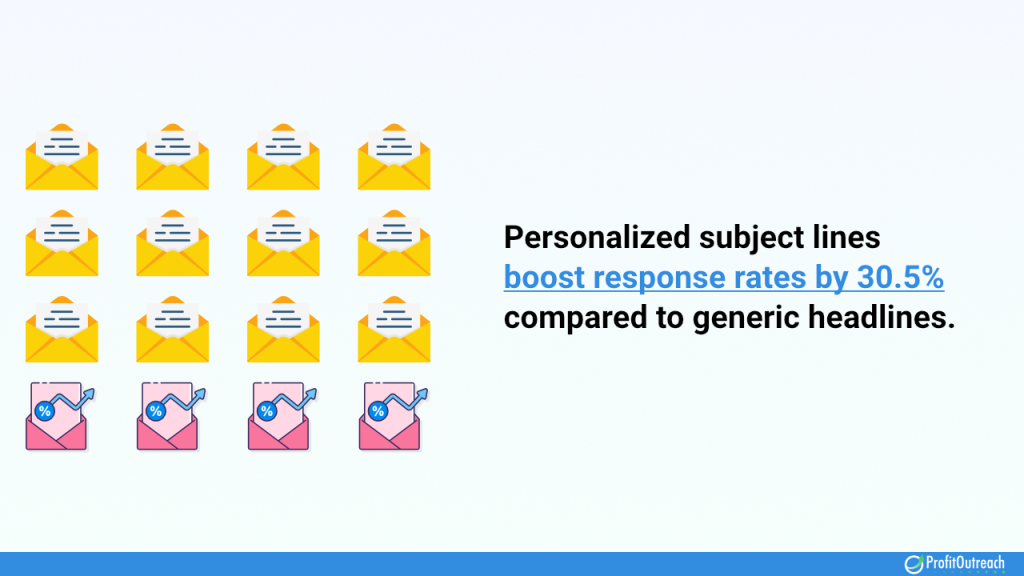
So, what does effective cold email personalization look like?
Essentially mentioning the prospect’s name, company, role, project, interests, etc. in a targeted way. This conveys that you did your homework on who they are and what challenges they face.
Here are personalized subject line examples to get you better understand what I mean:
- Question for ProfitOutreach’s social media strategy
- Research on healthcare trends for Priya Singh
- Following up re: supply chain issues, Alex
You can see how each of those quickly communicates relevance to the recipient.
The latter two examples add the personal touch of using first names, which can improve cold email open rates. Such segmentation shows the person behind the email cares enough to customize messaging.
Additionally, they can get a sense of what’s up. But on this later.
In essence, excellent cold email subject lines feel like they were written for an audience of one. They showcase familiarity with that individual prospect’s pain points – grabbing attention instantly amidst the email noise.
Practice #2: Call Out Their Names or Company Names
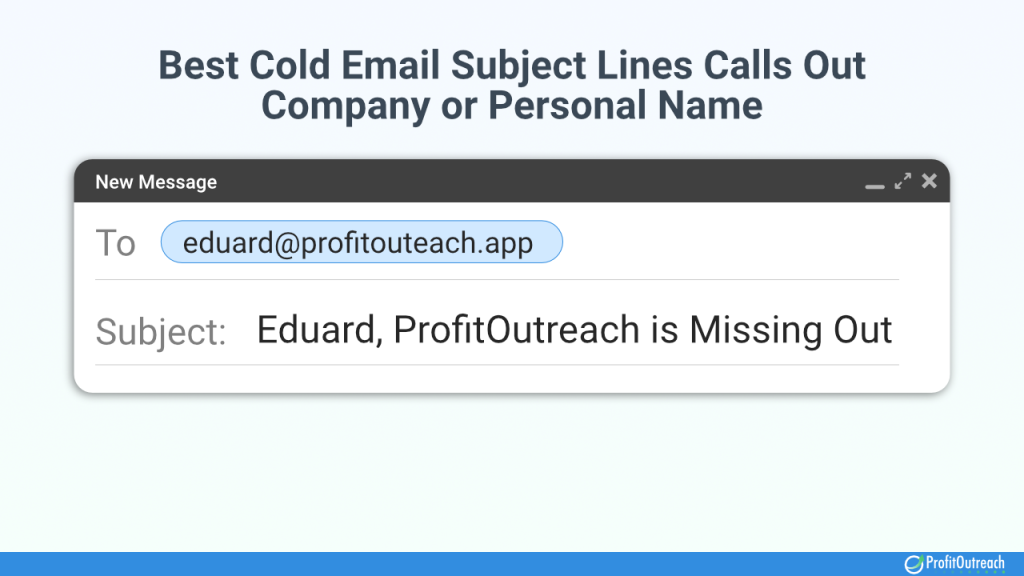
Digging deeper into personalization, multiple studies have found that including the prospect’s actual name or company name tends to boost open rates the highest.
As per Klenty, personalizing cold email subject lines with the recipient’s first name generates open rates of around 43.41%.
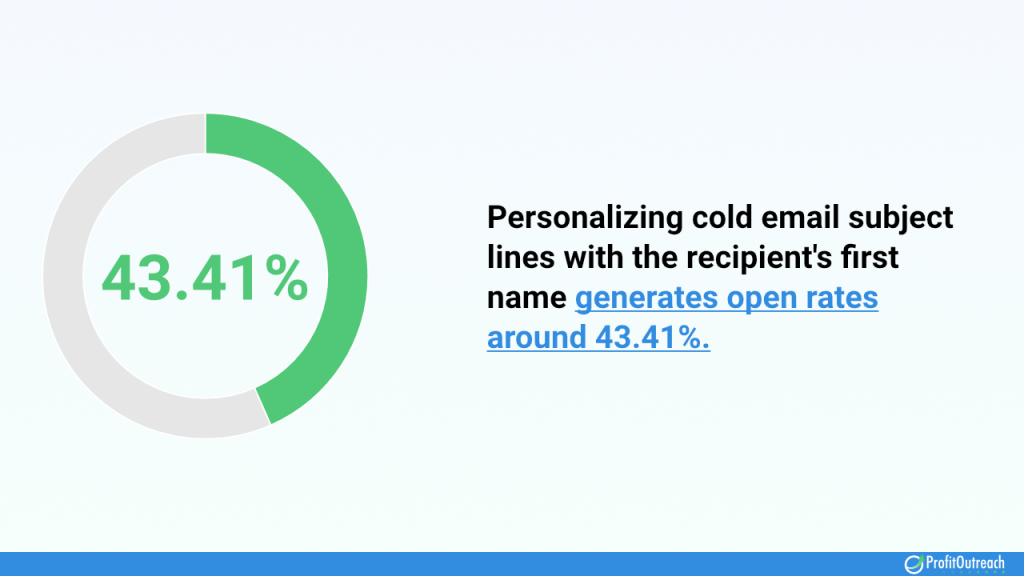
And from our experience, this checks out!
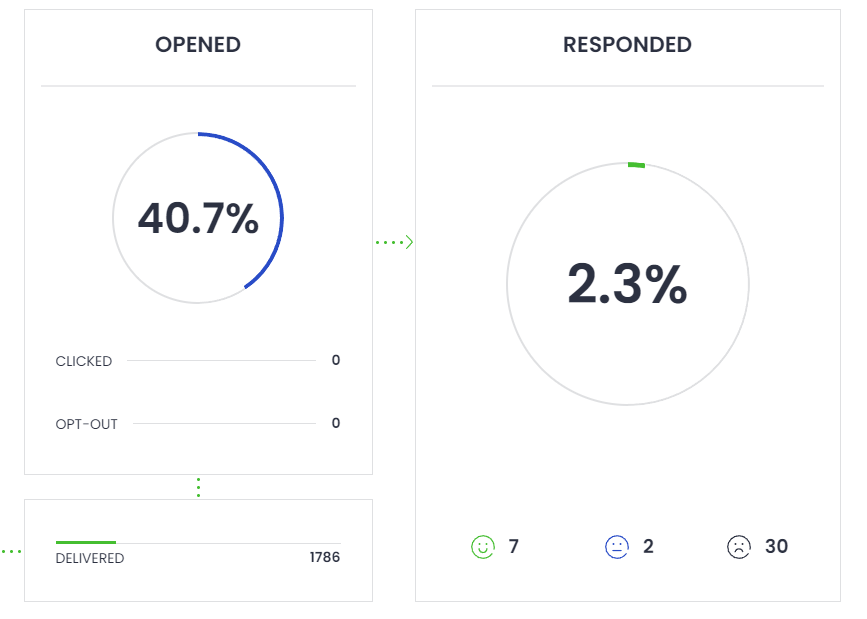
You can call out names in creative ways that pique interest, for example.
- “Question for Clara’s Social Media Strategy”
- “ProfitOutreach + Rocket Media – Potential Partnership?”
- “Question about supply chain issues at NexGen Technologies”
- “Clara Wells: A better way to boost conversions”
- “Alex, I thought you might be interested in this…”
These real examples make the core value proposition clear while highlighting relevance through names and companies.
They indicate you know who the person is and what they care about. This level of segmentation cuts through the impersonal nature of most cold outreach.
This is becoming even more important in a sea of generic subject lines!
Using prospects’ names gives your emails a better chance of capturing attention. According to OptinMonster, personalized headlines can improve open rates by as much as 14%. The more precise the personalization, the better, so incorporate role, company, needs, etc.
Practice #3: Mutual Connection Mention

Further personalizing your cold email subject lines can be done by name-dropping any mutual connections you share with the prospect.
This could be either an individual or company/brand connection.
For example:
- “Mary Smith recommended I reach out”
- “We both work with Company XYZ”
- “We have John Doe in common”
Casually mentioning these mutual ties makes the recipient feel safer opening and engaging with your email.
It establishes credibility through associations rather than coming across as random solicitation.
And luckily, you can obtain these connections through research on LinkedIn, company websites, or other public information.
Then feature them prominently right within cold email subject lines. If the reader sees you both share the same acquaintances, clients, or networks, they are more likely to perceive you as trustworthy.
This often translates to improved open and response rates.
Practice #4: Keep It Short

With mobile dominating email open rates, you want tight, scannable cold email subject lines.
According to GetResponse, 24.45% of all emails are opened on mobile devices – so this is essential real estate.
Campaign Monitor also found subject lines with around 41 characters or roughly seven words have the highest open rates. Anything lengthier tends to get cut off or flagged on small screens.
To illustrate brevity’s power:
- Long Version: “I wanted to reach out regarding potential opportunities to collaborate as our companies share similar target demographics”
- Short Version: “Joe, Possible collaboration for our shared audience?”
Even though the longer headline technically provides more detail, the concise version gets the point across with tight clarity and focus.
Eliminating fluffy phrasing spotlights your core value proposition. Readers instantly recognize what’s in it for them versus trying to parse verbose headlines.
Additionally, shorter cold email subject lines allow recipients to fully preview your message on mobiles or when emails are glimpsed in inbox views.
You don’t want vital text getting truncated.
So, remember – compelling yet brief. Identify the one key thing you want readers to grasp, leading with the most crucial element and trimming unnecessary nonsense.
This framing makes a strong first impression.
Practice #5: Provide Clarity and Relevance
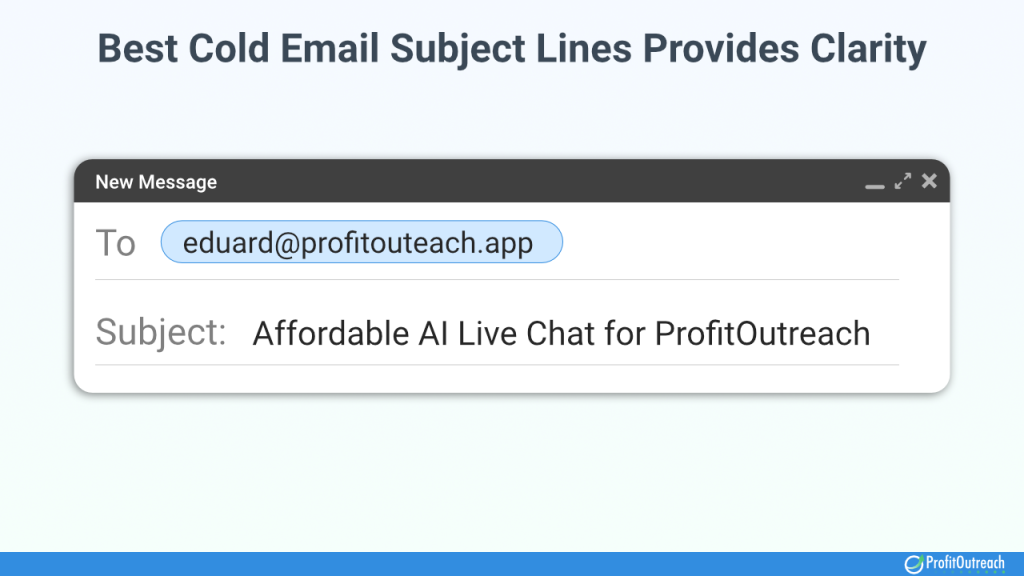
The most effective cold email subject lines offer extreme clarity on who the message is for and what it contains as well as what’s in it for the prospect.
You want recipients to quickly understand value, relevance to their problems, and the next steps.
For example, strong subject lines include:
- “Monitoring solution for supply chain delays”
- “Survey data on customer retention preferences”
- “Thoughts on partnerships for the fitness industry”
Rather than vague statements like “Great opportunity awaits” or “This is the most important solution for your business”.
You want your subject lines to zone in on reader-centric positioning. They indicate you understand priority issues and are providing solutions or insights around those pain points.
This framing comes across as an exchange of value versus a random sales pitch. Even if you don’t personalize by name here, be specific so readers recognize you aim to help them.
As well as you will prequalify them. Those with mentioned pain points will most likely respond to your message.
So, some elements to include:
- Their industry, niche, or operational areas.
- Buzzwords related to their known challenges.
- Types of research offers, or partnerships you provide.
Remember clarity is what initially earns attention amidst overflowing inboxes. When prospects instantly get who you are and your value to them, that relevance pays dividends in heightened engagement.
Practice #6: Provide Urgency or Curiosity
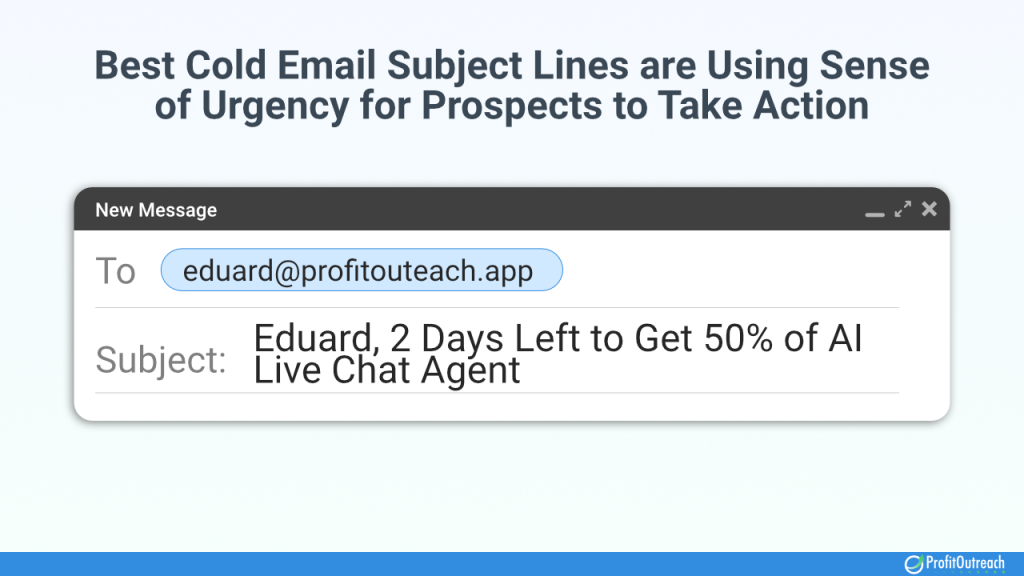
Urgency and curiosity are two very effective techniques you should embrace within your cold email subject line framing.
Urgency conveys timeliness – that the offer, insight, or suggestion you provide needs prompt attention for maximum benefit.
This sense of scarcity taps into recipient psychology to encourage faster action. For example:
- “24-hour flash sale on monitoring solutions”
- “Price increase announcement: act now!”
- “Last chance for exclusive early access”
You see how highlighting limited availability or narrow windows of opportunity apply pressure. The recipient feels they need to open quickly lest they miss out on special perks.
This works especially on prospects that are on the fence of knowing they might need your product or service, but are just not rushing to make a decision.
Alternatively, curiosity utilizes mystery, intrigue, and open-ended questions to pique the reader’s interest. For instance:
- “What if you could expand reach by 50% every quarter?”
- “Five underused tricks to improve lead gen”
- “Here is how you can double your sales from cold email?”
This framing feels more like storytelling versus a sales pitch, engaging the imagination.
The subject line pulls readers in by hinting at fascinating lessons or counterintuitive ideas inside. Curiosity gives your cold email added zest and personality versus generic benefit statements.
In both approaches, the art lies in the balance – apply gentle urgency or curiosity without aggressive hype or deceptive gimmicks.
When done right, embracing these principles wins more opens.
Practice #7: Avoid Spam Triggers
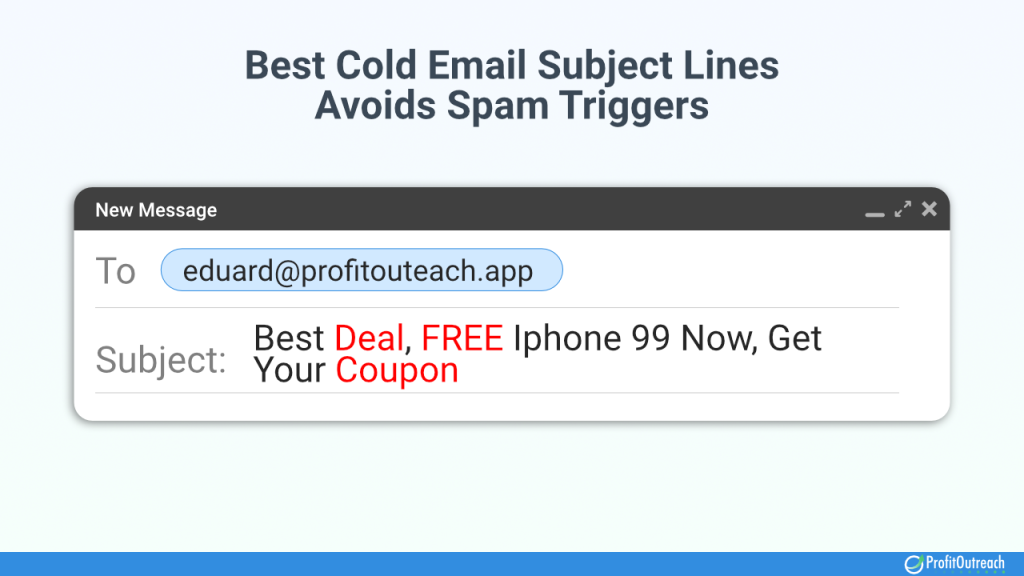
You want cold email subject lines to sail smoothly to the intended inbox without getting labeled as spam.
If your cold email lands in the spam folder, forget about any results. It’s like flashing cash into a toiler. Quite literally.
Therefore you should know certain words that negatively trigger spam filters such as:
- Free
- Deal
- Offer
- Discount
- Alert
- Prize
- Coupon
And there are many more!
And while these may accurately describe legitimate offers or content you provide, spam filters are overzealous. Too many instances of the above words could redirect your emails to the updates or promotions folder if not spam. (Learn more about cold email vs spam email)
Similarly, avoid ALL CAPS and overusing punctuation like !!! which seems salesy or scammy.
So, the best practice is to focus on a value proposition. What’s in it for your prospects? Don’t push it, offer it.
Practice #8: Testing & Optimization
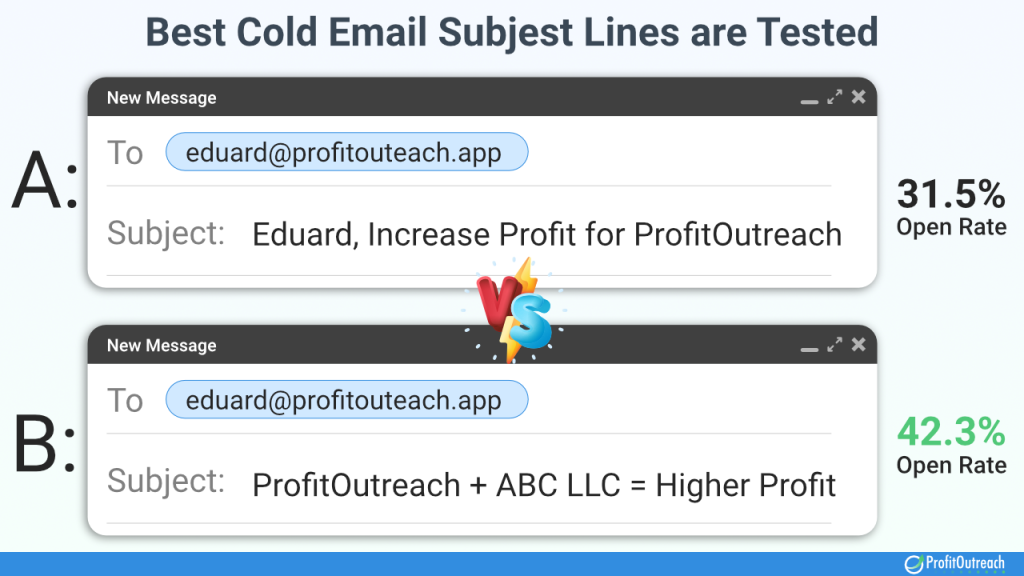
The most effective way to refine your cold email subject lines is through continual testing and optimization.
And A/B testing different subject line versions is the most popular and valuable optimization method!
As per TrueList, 60% of organizations find A/B testing highly effective for improving conversions.
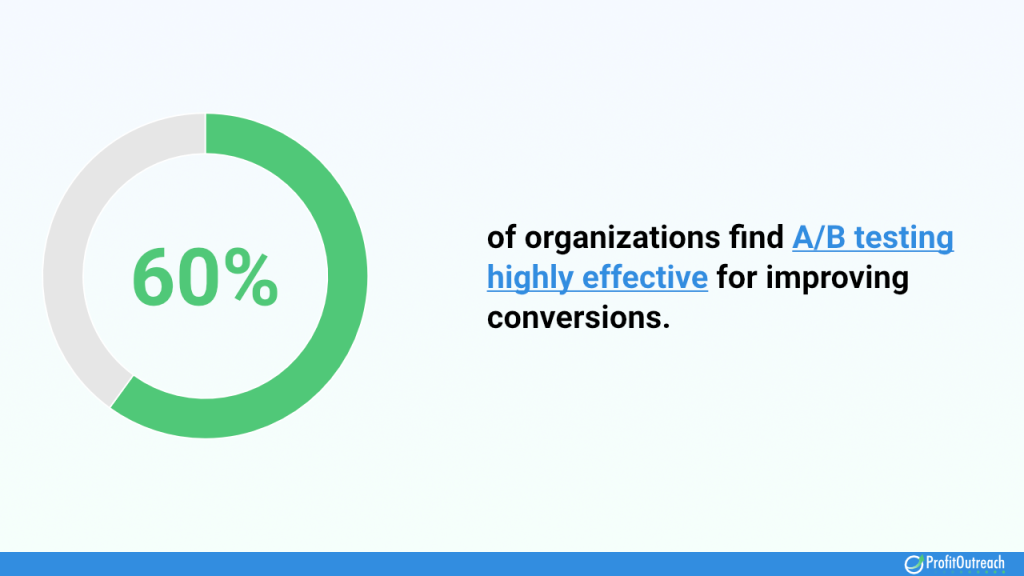
So here are some quick ways to test subject lines:
- Personalized vs Generic: Send one campaign with impersonal subject lines, and another highlighting custom names/companies. Gauge open rate lift.
- Framing Variations: Send one email series with problem-focused subjects, and another with benefit-driven subjects. See what propels more clicks.
- Power Words Swaps: Substitute different power words and emotional phrases to identify what resonates most.
Ideally, build these tests into campaigns from the start, using past performance data to optimize future outreach.
Over time, you uncover what types of phrasing, offers, and personalization convert best for cold contacts.
Testing also shows what resonates with particular roles, regions, or industries.
Ongoing subject line optimization is key for continual refinement. Even slight tweaks to language can substantially lift open rates, so always be iterating based on data.
So I recommend you use platforms with A/B testing capabilities such as WoodPecker, Lemlist, or Instantly.
Practice #9: Use Power Words & Phrases
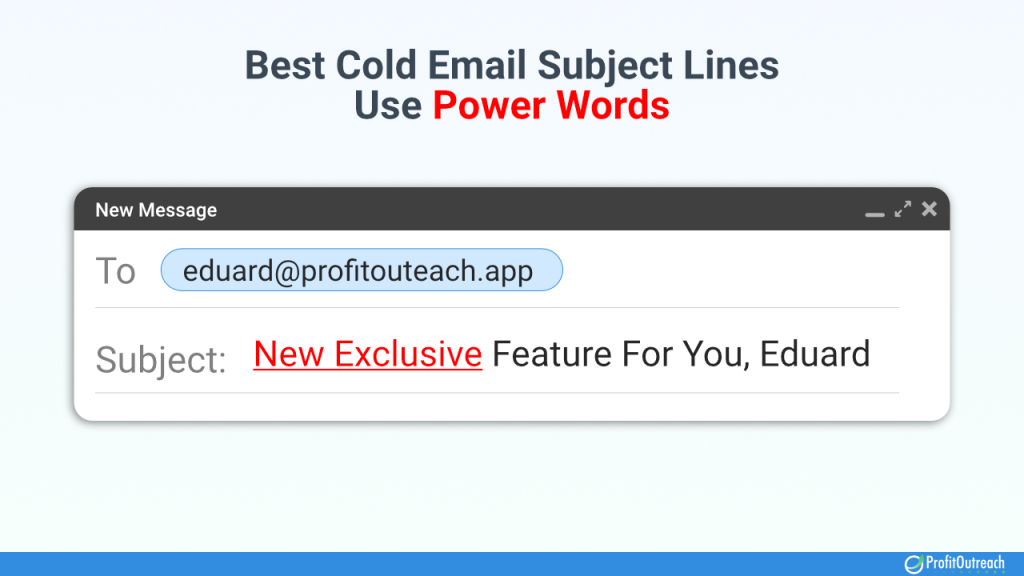
Incorporating strategic power words and emotional phrases is another way to supercharge cold email subject lines.
These vocabulary sparks get readers feeling, imagining, and anticipating within headlines to fuel engagement.
For example, some of the power words include:
Discover, Solve, Profit, Love, Instant, Exclusive, Proven, Imagine, Miracle, Secret, Guaranteed, Obsessed, Triumph, Sensational, Risk-Free, Behind-the-Scenes.
Layer these strong verbs, adverbs, and adjectives that imply excitement around core positioning.
For example instead of “New software demo available”, try “Instantly discover revolutionary software in special 1-on-1 demo”.
Or instead of “Get 50% off your purchase”, try “Get exclusive 50% off your purchase”.
When evaluating power words and phrases, ensure they feel genuine instead of hype-up.
Always practice restraint so as not to trigger spam filters.
Most importantly, you should highlight legitimate value being exchanged rather than fabricating Scope and evergreen appeal or over-promising.
But, still, sprinkling the right terms stimulates reader enthusiasm and urgency within subject lines for improved performance.
Practice #10: Apply Cold Email Copywriting Techniques
Effective cold email subject lines leverage proven cold email copywriting techniques to capture attention and drive action.
So, start by focusing on the recipient’s pain points or interests, using compelling language that resonates with their specific needs.
For example, instead of a generic “Increase Your Sales,” try “Boost Your Sales by 30% with Our Proven Strategy.”
You also want to use power words that evoke curiosity and urgency, such as “Discover,” “Exclusive,” or “Limited Time.”
These words trigger an emotional response, prompting recipients to open your email.
Additionally, ask open-ended questions that engage the reader, like “Are You Maximizing Your Marketing ROI?”
Remember to keep the subject line concise and clear, ideally under 50 characters, to ensure it displays fully on mobile devices.
By applying these copywriting techniques, your cold email subject lines will stand out in crowded inboxes, leading to higher open and response rates.
Effective Examples of Subject Line Examples
Now that we’ve covered best practices, here are 12 categories with specific cold email subject line examples you can model.
These demonstrate personalization, power words, urgency, and value framing in action. Use these templates as inspiration, customizing messaging to resonate with your particular prospects’ pain points and goals for maximum impact.
Personalized Inquiry:
- “{First_Name}, Can We Improve Your [Service/Area of Interest]?”
- “Seeking Your Insight on [Industry Trend], {First_Name}”
Curiosity and Relevance:
- “Discover a Unique Approach to [Industry Challenge]”
- “Is Your [Department/Team] Facing This Common Hurdle?”
Value Proposition:
- “Unlocking New Opportunities in [Prospect’s Industry]”
- “How We Helped [Similar Company] Achieve [Specific Result]”
Urgency and Timeliness:
- “Limited Time Offer for [Prospect’s Company Name] on [Service/Product]”
- “Act Now: Exclusive [Product/Service] Benefits for [Industry] Leaders”
Problem-Solving:
- “Eliminate [Common Pain Point] with This Strategy”
- “[Prospect’s Company Name]: Streamline Your [Process/Operation] Today”
Networking and Connections:
- “Joining Forces: How [Mutual Connection] Sees Our Potential Collaboration”
- “[Mutual Connection]’s Success Story with [Your Product/Service]”
Educational and Informative:
- “Insights into [Industry Trend/Challenge] for [Prospect’s Company Name]”
- “Exclusive Webinar Invite: Mastering [Relevant Skill/Topic]”
Customized Offers:
- “Tailored Solutions for [Prospect’s Company Name]’s [Specific Need]”
- “[Prospect’s Name], Explore Our Customized [Product/Service] Offer”
Event Invitations:
- “Invitation: [Prospect’s Name], Join Us at [Event Name]”
- “Meet Us at [Event/Conference], [Prospect’s Name]”
Feedback and Engagement:
- “Your Thoughts on [Recent Industry Development], {First_Name}?”
- “{First_Name}, How Can We Better Support Your Goals?”
Success Stories and Case Studies:
- “How [Similar Company] Overcame [Challenge] with Our Help”
- “[Case Study] Transforming [Industry Aspect] at [Similar Company]”
Intrigue and Novelty:
- “Unveiling a Revolutionary Approach for [Prospect’s Industry]”
- “Exclusive Preview: Next-Gen Solutions for [Industry/Field]”
Follow-Up and Reminders:
- “Just Checking In: Any Thoughts on Our Last Conversation?”
- “Reminder: Don’t Miss Out on This Opportunity, [Prospect’s Name]”
Exclusive Offers and Opportunities:
- “Exclusive Access for [Prospect’s Company Name] to Our Latest [Product/Service]”
- “Inviting [Prospect’s Company Name] to Our VIP Client Circle”
Industry-Specific Insights:
- “Breaking Down the Latest [Industry] Trends for [Prospect’s Company Name]”
- “[Prospect’s Name], Are You Ready for [Industry Change/Innovation]?”
Personal Achievements and Milestones:
- “Celebrating Your [Achievement/Award] with a Special Offer”
- “[Prospect’s Name], Your [Recent Achievement] Impressed Us!”
Collaboration and Co-Creation:
- “Collaborate with Us on [Project/Initiative]?”
- “Your Expertise Needed: Co-Create the Future of [Industry/Field]”
Feedback Requests:
- “We Value Your Opinion on [Product/Service]”
- “[Prospect’s Name], Your Feedback Can Shape Our [New Product/Service]”
Invitations to Participate:
- “Join Our Exclusive Roundtable on [Relevant Topic]”
- “Invitation: [Prospect’s Name], Share Your Insights on [Panel/Discussion]”
Problem-Solution Format:
- “Tired of [Common Problem]? Here’s a Unique Solution”
- “Solving [Prospect’s Company Name]’s Challenge with [Innovative Solution]”
Seasonal or Event-Related:
- “Spring into Action: Special [Season/Event] Offer for [Prospect’s Company Name]”
- “[Holiday/Event] Special: How We Can Make It Extra Special for [Prospect’s Company]”
Success and Growth Focus:
- “Grow Your Business with Our Proven [Strategies/Tools]”
- “Empowering [Prospect’s Company Name] to Reach New Heights”
Innovative and Creative Angles:
- “Redefining [Industry/Process] – How [Prospect’s Company Name] Can Benefit”
- “Innovate with Us: Exploring New Horizons in [Industry/Field]”
Personalized Questions and Queries:
- “How Does [Prospect’s Company Name] Tackle [Specific Issue]?”
- “[Prospect’s Name], What’s Your Take on [Industry Trend/Topic]?”
Conclusion
Crafting the best cold email subject lines is a really “it depends” answer but hugely impacts your outreach success.
Because what works for me, might not work for you. But proven cold email best practices always help to get you off to a good start and then you just need to find what works the best for you,
As the Woodpecker study showed, highly personalized emails and subject lines increase reply rates by up to 142% compared to generic outreach.
By focusing on relevance, urgency, and value highlighting real prospect needs, you grab attention amid overflowing inboxes.
Subject lines optimized through continual testing and power word integration compel action. They get your foot in the door so prospects actually read, respond, and convert rather than ignoring messages.
While the headline craft requires finesse, the guidelines in this article equip you to transform cold email subject line performance.
Now you have the practices and tactical examples to build curiosity, trust, and engagement through words – opening the door to more fruitful conversations.
Craft Highly Converting Cold Email Sequences
Experience the power of truly personalized cold email sequences with ProfitOutreach!
We transform your prospect’s data and your unique offer into captivating, tailored email sequences for each of your prospects.
Elevate your conversion rates and maximize your profits from cold email campaigns. Join us now and watch your profits soar – sign up today!
FAQs about Best Cold Email Subject Lines
Here are the answers to the FAQ questions related to cold email subject lines and cold email:
What is a good subject line for a cold email?
A good cold email subject line clearly communicates relevance through personalization, highlights value propositions, and compels action using power words or urgency.
Which of the best subject line for an email?
The best subject lines feature the prospect’s name/company, specifics about their needs, power words like “discover” and “exclusive,” and clear next steps.
What email subject lines get the most opens?
Emails with subject lines under 50 characters that provide ultra-specific value positioning around the recipient’s needs/pain points achieve the highest open rates.
What is a good intro for a cold email?
An effective cold email intro briefly establishes credibility, references any mutual connections, and transitions smoothly into explaining core value propositions.
What is a catchy subject line?
A catchy subject line creatively utilizes emotional phrases, intrigue through storytelling, or curiosity gap patterns that capture the reader’s interest to click and learn more.
What makes a catchy subject line?
Personalization, urgency, novelty, asking questions, envisioning success, and leading with the most compelling detail make for catchy subject lines.
How do you write a powerful cold email?
Powerful cold emails lead with relevant subject lines, briefly explain value, make asks easy through clear calls-to-action, showcase personalization, and focus entirely on the prospect’s needs.
What not to say in a cold email?
Avoid generic sales language, overused salesy phrases, inflated claims around deliverables, and hard sells in cold emails – focus on value.
Related Articles:
- Best cold email generators for businesses
- How to Improve Cold Email Deliverability: Best Practices
- How to Find Email Addresses for Cold Emailing
- Write the Best Cold Email Call To Action: Examples, Best Practices, and Tips
- Best Cold Email Software
- How to Create a SaaS Cold Email Strategy
Cold Email Templates:
- Value Proposition Cold Email Template Guide: Examples, Best Practices, and Tips
- Break-Up Cold Email Template Guide: Examples, Best Practices, and Tips
- Use Cases Cold Email Template Guide: Examples, Best Practices, and Tips

